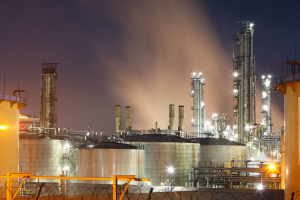Oil & Gas Executive Outlook 2015
 In our recently conducted survey of more than 200 senior executives from across the oil and gas energy spectrum, we discovered the trends, issues and challenges they expect to see in 2015 and beyond. These industry leaders weighed in on such issues as headcount expectations, capital spending, merger and acquisition expectations, and more.
In our recently conducted survey of more than 200 senior executives from across the oil and gas energy spectrum, we discovered the trends, issues and challenges they expect to see in 2015 and beyond. These industry leaders weighed in on such issues as headcount expectations, capital spending, merger and acquisition expectations, and more.
>>Learn more and see data charts in the PDF of the full study.
A Challenging Year Ahead
The five-year outlook is optimistic, but most executives expect their industry segments to have a challenging year in 2015, primarily due to lower oil prices. When asked how they expect their industry segment to perform next year compared to 2014, 19 percent said they expect their segments to perform moderately better or significantly better, while 59 percent said they expect their segment to perform moderately worse or significantly worse.
We asked the participants from all segments which industry segment will perform best in 2015, and two areas stood out: downstream (the refining, fuel retail marketing and petrochemical segment) and the majors (integrated oil and gas companies).
When we asked the executives how they expect their own companies to perform in 2015, 32 percent said “better than 2014,” while 39 percent said “worse.” Also, 22 percent expect to see increased total headcounts at their companies in 2015, 36 percent expect to see lower headcounts and about 42 percent expect their companies’ total headcount to stay about the same.
When it comes to capital spending, most companies expect a retreat from the record spending levels of the last few years. About 17 percent of the survey participants expect their companies to increase their capital spending, while 54 percent expect their companies to reduce their spending.
Mergers & Acquisitions Expected to Increase in 2015
Mergers and acquisitions are expected to increase quite a bit in 2015. Certainly, the recent announcements of the $34.6 billion Halliburton/Baker Hughes merger and the $8.3 billion Talisman acquisition by Repsol support this expectation.
Of the executives surveyed, 70 percent expect an increased level of M&A activity, while only 16 percent expect less, and 14 percent expect M&A activity to be about the same as 2014.
Oil and Gas Prices Will Remain Soft in 2015
According to the majority of survey participants (59 percent), the 2015 average price for WTI oil will be in the range of $65 to $80 per barrel. About 34 percent of participants believe the price will be in the $50 to $65 range. Very few of the executives feel that oil will be below $50 (2 percent) or over $80 (5 percent).
As a point of reference, during the days that the survey was conducted (December 8-12, 2014) oil traded in the $57 to $65 range. Oil spent most of 2014 in the $80 to $100 range, with a dramatic drop occurring in the weeks just before our survey.
Sixty-seven percent of survey participants expect natural gas prices to average about $3.00 to $4.00, and 26 percent of participants believe natural gas will average $4.00 to $5.00 in 2015. A small number (7 percent) expect prices to be below $3.00. For reference, natural gas prices were in the $4.00 to $5.00 range for most of 2014.
Very Strong Five-Year Outlook
When asked how they expect their industry segment to perform over the next five years, a striking majority of the participants were positive: 76 percent said significantly or moderately better. Very few were negative: Only 6 percent said “moderately worse,” and none said “significantly worse.” Few (18 percent) expected their segments to perform about the same.
Similarly, when asked about their individual companies, 83 percent expected their companies to perform better over the next five years, while 5 percent said that their companies would perform worse.
According to the entire group of survey participants, the two industry segments that are expected to perform the best over the next five years are the majors (integrated oil and gas companies) and independent exploration and production companies.
Industry Tailwinds
When considering their own industry segment over the next five years, we asked the participants which were the most important drivers of opportunity, or tailwinds. The top three tailwinds cited are, in order: 1) global economic recovery, 2) new technology developments and 3) increased use of natural gas. New technology developments in the areas of hydraulic fracturing and drilling were cited most often. The increased use of natural gas in power generation was identified as the leading driver in the overall increased consumption of natural gas.
Industry Headwinds
Similarly, we asked the participants to identify the most significant challenges, or headwinds, that their industry segments will face over the next five years. The top four headwinds cited are, in order: 1) global oversupply of oil and gas, 2) unfavorable prices for oil, 3) increasing regulation/restrictions/taxes and 4) talent shortages. Two areas stood out in the answers for increased regulation/restrictions/taxes: A) local or regional bans on hydraulic fracturing, and B) increasing regulation or restrictions by the EPA.
Talent-Related Challenges
The survey participants were asked to identify the top talent-related challenges that they expected their industry segment to experience over the next five tears. The number-one issue cited was the “Great Crew Change,” or the retirement of key personnel expected in the near future. The second-most significant talent-related issue is the shortage of technical talent, such as engineers and geoscientists. The third-most-cited issue is the lack of leadership talent.
Summary
The oil and gas industry expects 2015 to be a challenging and dynamic year:
- Lower oil and gas prices will continue in the short term.
- Lower capex is expected in many companies.
- Headcount reductions are expected.
- Increased mergers and acquisitions are predicted.
- Integrated majors and downstream companies are expected to perform better than other segments.
However, the longer, five-year outlook is much more optimistic:
- Most companies and industry segments are expected to perform better.
- Independent E&P companies and the integrated majors are expected to perform best.
- The “Great Crew Change”—retirement of key personnel in the near future—as well as global oversupply of oil and natural gas production are expected to be the biggest challenges.
- Global economic recovery is expected to be the most significant long-term opportunity driver.
About the Survey
The survey was conducted between December 8 and 12, 2014. Of the 205 participants, 63 percent are at the C-level (chief executive officer, chief financial officer, etc.) or vice-president level. About 80 percent of the participants reside in the United States, with the other 20 percent residing in a variety of countries across the globe. Independent E&P companies and major integrated oil and gas companies account for 29 percent of the survey participants. Another 36 percent work for oilfield equipment and service companies, and the remaining 35 percent work in a variety of other industry segments.
Related Posts
- ← Apply Dieting Lessons to Your Executive Job Search
- The Global Economy and Its Effect on Our Business Climate →














